Subscapularis Tendon Injuries
The Normal Subscapularis:
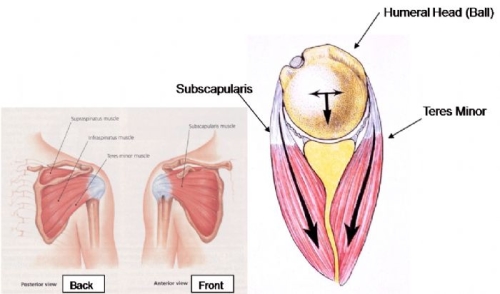
The subscapularis, located in the front of the shoulder, is one of the four muscles that make up the rotator cuff. It is the most powerful of all the rotator cuff muscles. Its function is to help the shoulder joint move and create powerful motions such as internal rotation, which occurs when the arm is pulled toward the body as with a tennis stroke or with swimming.
Subscapularis tendon injuries are relatively rare. Most injuries of the rotator cuff involve either the supraspinatus tendon on top of the shoulder or the infraspinatus tendon in back of the shoulder. Subscapularis tendon injuries usually occur as the result of a traumatic event, such as a fall, and usually affect individuals who are younger than those who typically present with a supraspinatus tendon tear. Tendon tears of the subscapularis may also occur after a surgery, such as a total shoulder replacement, in which the subscapularis tendon is removed and then repaired as part of the surgical procedure.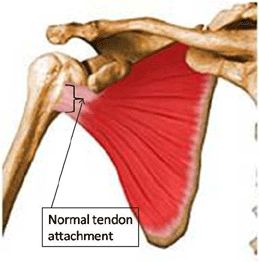
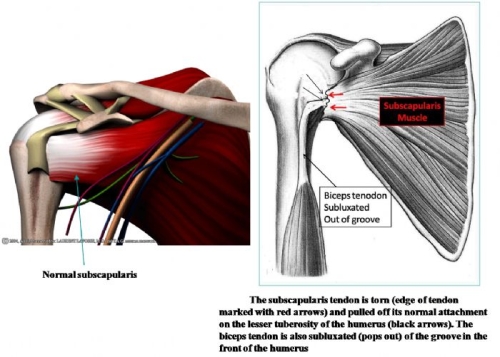
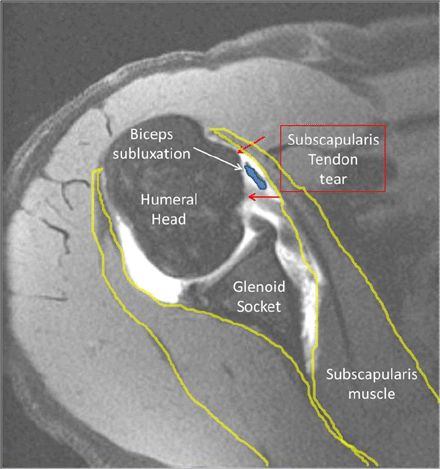
MRI showing subscapularis tendon tear and biceps tendon subluxated out of its normal position.
A 46 year old truck driver fell off his truck and tried to break his fall by holding on to the side of the door with his right arm. He felt a tearing sensation and then has had pain and weakness since. His examination demonstrates the typical findings of a subscapularis tendon tear.
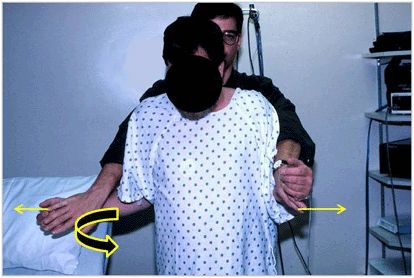
The examiner tries to pull outward (yellow arrows) and the patient resists. On the injured side his internal rotation strength is weaker (curved black arrow) so his arm can be pulled outward.
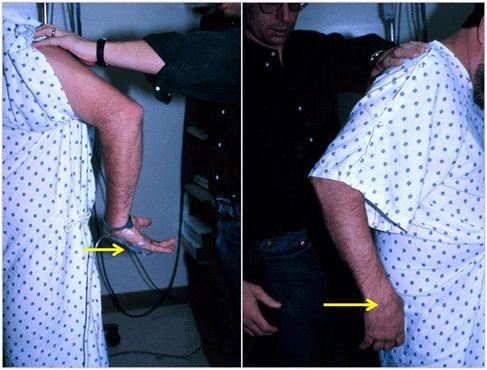
On the normal side the patient is able to lift his hand off the lower back (image on left and yellow arrow). On the injuried side the patient is unable to lift the hand off the lower back (image on right and yellow arrow). This is called a positive lift-off sign.
Since the subscapularis tendon is a very important part of normal shoulder function, it should usually be fixed surgically if it is torn. In most cases, this can be accomplished using arthroscopic techniques. This type of surgery may be performed under a local nerve block and as an outpatient procedure in which the patient may be discharged home on the day of surgery.The repair entails finding the torn edge of the tendon, mobilizing it from its scarred position, and then reattaching it to its normal position on the edge of the humerus. This is accomplished with special instruments and through the use of arthroscopic suture anchors. First, the bone is roughened to promote tendon healing into the bone. The anchors are then placed into the bone. Sutures from these anchors are then passed through the tendon in order to attach it back to the bone.Video of Arthroscopic Repair: This video shows an arthroscopic repair of a partial subscapularis tendon tear involving only the upper portion of the tendon. (Courtesy of Dr. Laurent Lafosse). (Click Here for Video)
How Successful is Subscapularis Repair Surgery?
The most important factors for success are quality of tendon tissue and cooperation of the patient with a gradual return to activity after surgery. The factors that affect quality of the tendon tissue are delay to actual surgery and history of smoking. Clinical experience has demonstrated that patients who have surgery within 6 months of the injury do better than those with a longer delay prior to surgery. Smoking affects tendon quality as tendons that tear may deteriorate as a consequence of the effect of chemicals in smoke. Early return to active and forceful use of the arm may also result in retearing of the repaired tissue.The reported success of subscapularis repair is excellent. More than 90% of patients experience marked improvement in pain and strength after repair of a torn subscapularis tendon.
Q – If I don’t have my tendon repaired can I expect a good outcome?
A – Subscapularis tendon tears, when the occur after trauma, typically occur in individuals who are younger than those who have degenerative tendon tears. These may occur after a specific trauma and are not uncommon as work-related injuries in active males in their 3rd through 5th decades. These tendon tears may also occur after a shoulder surgery where the subscapularis is repaired following surgery. In such cases, failure to repair the subscapularis tendon is associated with a poor outcome in a large percentage of individuals. Clinical experience has shown that the tendon tear will enlarge and the muscle quality will degenerate if the repair is not performed before six months from the date of the specific injury.
Q – How successful is the surgery?
A – The success of surgery depends greatly on the quality of the tendon tissue and this is directly related to the chronicity of the tear. An acute subscapularis tendon tear is generally associated with good tissue and a good outcome of surgery. The clinical experience has been that both arthroscopic and open repair methods can achieve satisfactory results in over 90% of the patients having surgery.
Q – What are the risks of surgery?
A – In addition to the usual (rare) risk of anesthesia, there are several risks of surgery. These include failure to relieve pain, stiffness, retear of the tendon, nerve injury and bleeding. Infection rates are lower with arthroscopic than with open surgery but overall well under 1% risk.
